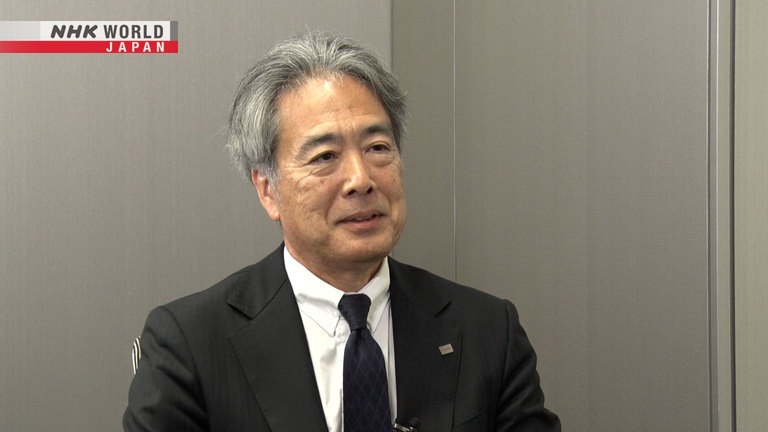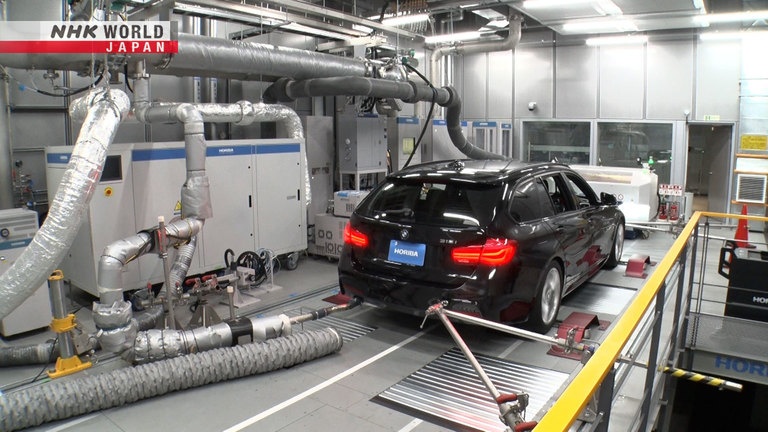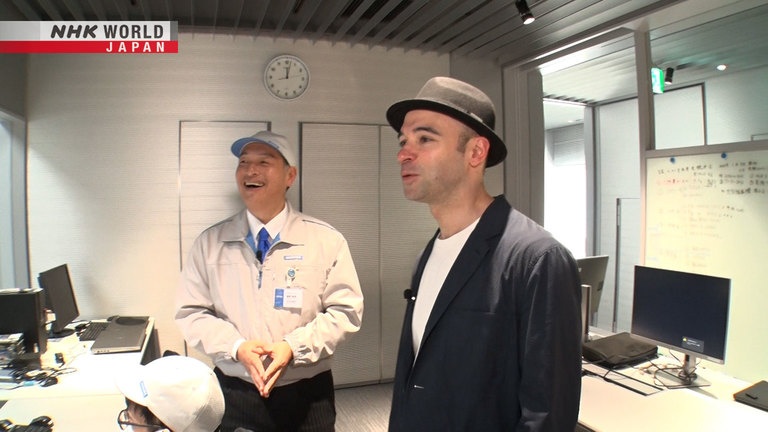Letter Sorting Machines / Exhaust Gas Analyzers
The stories behind hit Japanese products, plus top creations for niche markets. This time: letter sorting machines & exhaust gas analyzers.



Transcript
"Japan's Top Inventions"
The behind-the-scenes tales of hit products and creations from Japan.
This is "Japan's Top Inventions."
On today's show...
letter sorting machines used around the world.
These systems help make deliveries easier.
We'll share how they were invented.
Whoa. Is that...
Is that a car in there?
Later... a certain company's lab.
The tires are spinning...
and a plastic bag is inflating.
Just what is going on?
Stay tuned to find out.
Hello, welcome to "Japan's Top Inventions."
I'm your host, Jason Danielson.
In the first half of the show, we take you "Behind the Creation."
Today's topic is this.
Letter sorting machines.
This is a model used in Japan.
Postal codes and addresses are read in an instant.
It can automatically sort 14 letters in a single second.
These machines are also found in countries like Korea, France, and Canada,
supporting a vast number of postal deliveries each day.
It was developed by a major Japanese electronics manufacturer.
Figuring out how to recognize handwritten characters
would prove to be a great challenge.
The headquarters of a major electronics manufacturer
in the Greater Tokyo Area.
Inside is a display room telling the company's history.
Many of their products were innovative.
Over on this wall...
This was the first in the world.
A picture of the company's first letter sorting machine developed in 1968.
The machine recognizes handwritten postal codes.
Letters are sorted by destination.
It works some ten times faster than a human.
Over 20,000 letters can be sorted in an hour.
The technology for recognizing handwritten characters
enabled the mail to be delivered faster and more accurately.
It was a big help to Japan's postal service.
Our story begins back in the 1960s.
As Japan's economy developed,
the number of items in the post increased significantly.
At times, the number exceeded the amount that could be sorted by hand,
resulting in delivery delays.
To address this, the government introduced the postal code system.
Areas across Japan were given unique codes.
The mail would be sorted using the numbers.
The system would make postal deliveries more efficient.
A major electronics manufacturer saw this as an opportunity.
A project was started at the company.
It was called the "LH Project," short for "Letter Handling."
The goal would be to develop a machine
that could read postal codes and automatically sort the mail.
Ishibashi Yuichiro works on the development of the sorting machines.
Here's what he heard about those times.
The government believed that automation was necessary
to deliver mail quickly and correctly.
Sensing the opportunity,
the head of the company put together a special development team.
The developers quickly got to work.
There was a long road ahead.
First, the developers considered how the letters would be moved.
The machine was to read codes off envelopes or postcards.
There needed to be some mechanism to move the items through the machine.
Letters in a bundle had to be taken in one at a time.
Then they would be divided into boxes by the address.
They needed some way for the machine to move the items.
The team worked diligently on the problem.
Eventually, they decided to make use of rollers and belts to convey the papers.
But then, one day...
an item tore and jammed the mechanism.
The problem was with how the mail items were different sizes.
From postcards to envelopes, the items had varying thicknesses and sizes.
This caused the machine to jam.
There are branches inside the machine that split off to the right or the left.
Items would jam in those spots.
It was common early on.
The developers kept experimenting with various postal items.
They adjusted the width of the belt and the speed of the rollers
to reduce the occurrence of jams.
There was one other major technical hurdle for the project.
How would the machine read the postal codes on the letters?
There was an issue which made development extremely challenging.
Typewriters were not common in Japan at the time.
Postal codes were mostly handwritten.
There were variations in line thickness, size, darkness,
and where characters were written.
With handwriting, you basically have infinite variations.
Individuals have totally different styles.
100 people have 100 different ways of writing.
Even with the same person, their writing can change
whether they're using a ballpoint pen or a felt-tipped one.
Could a machine really recognize handwritten postal codes?
The team had hit the wall.
A machine which could read postal codes and sort letters by destination.
Multiple companies in Japan had been searching for a way
to reliably recognize handwritten characters.
But the development team here had a certain idea they wanted to try.
How to automatically read handwritten characters...
After much consideration, the team had an idea.
A small camera would capture the writing,
and a computer would determine what was written.
For example, the camera would take a black and white photo.
You would get black writing on a white background.
This black and white image would be sent to a computer,
and the program would determine what text was written.
Blocks to write numbers in were prepared.
The blocks were subdivided into nine sections.
The computer would check what lines were in each section.
From this, the program would decide what the character was.
It was time to create the prototype.
Real handwritten samples would be needed for testing.
The team needed as many samples as they could get.
Part-time workers visited 1,200 homes,
asking people to write the numbers zero to nine, four times each.
From this, a total of 48,000 samples were collected.
The digits were photographed and run through the computer,
but there were samples which could not be recognized.
Some numbers were partially outside the blocks.
Others were connected, like cursive writing.
When the numbers are connected,
it's hard to tell which lines are part of the number
and which are just joining them.
There were styles like that which were hard for the computer to interpret.
In order for the computer to handle these difficult-to-recognize characters,
even more samples were needed to refine the program.
The team put out the call again for more samples.
This time, they gathered some 300,000 handwritten digits.
They spent days photographing each sample,
eventually determining some 4,000 different patterns.
The prototype continued to improve as the text recognition became more accurate.
March 1967.
The prototype letter sorting machine was finally complete.
Now to see how well it held up at the post office.
Officials from the postal authority were invited for a demonstration.
One hundred items would be sorted.
How well would the machine do?
Nervously, a team member loaded the items.
He held his breath, and started the machine.
The sorting took a mere 20 seconds.
When they looked at the results,
they found that 90 out of 100 had gone to the right boxes.
Ninety percent accuracy.
The officials were impressed.
The machine was more accurate than the competition.
I think they were satisfied with the level of performance.
The machine passed that test of sorts,
and the Tokyo Central Post Office placed an official order.
And so, in the summer of 1968,
the Tokyo Central Post Office installed their first letter sorting machine.
Letters going out of Tokyo to across the country
were sorted automatically instead of by hand.
However, the true challenge was yet to come.
At the end of the year, the machine would face its greatest test.
New Year's cards.
An enormous number of cards are sent in December
for delivery on New Year's Day.
Some years, over a billion are sent.
The challenge with New Year's cards is
that they are delivered on the morning of January 1st.
You have to process way more items than usual.
There's the worry that the machine might break down or have trouble.
Late December.
New Year's cards continued to flow into the Tokyo Central Post Office.
Seasonal staff were hired to help sort the vast number of cards.
Working alongside them?
The letter sorting machine,
quickly and automatically organizing stacks of cards.
It was a great help to ensure that the New Year's cards went out on time.
Afterwards, the letter sorting machines spread across Japan and around the world.
How do experts view this invention?
We're joined by Fujiyoshi Hironobu to learn more.
Welcome to the show.
Thanks for having me.
A letter sorting machine which recognizes handwritten characters.
What's your opinion about this device?
With handwriting, the same character can look different depending on the writer.
How do you tell what's been written?
For example, with the number two.
Some write it taller, some wider. It can change a lot.
With all these variations in mind,
being able to recognize the character anyways is really something special.
How do you think text recognition technology is going to evolve?
They're going to train the systems with a lot of data.
For example, with business cards.
They'll be able to read those.
In addition to names, business cards have info like addresses,
job titles, company names, and telephone numbers.
They'll be able to recognize this information from the cards
by training the systems with data.
What can Japanese companies offer the world with text recognition technology?
Japanese companies are very good with hardware and manufacturing.
By pairing current AI technology with manufacturing,
they'll be able to recognize all kinds of text,
like business cards or invoices.
I think they'll be able to come up with things
that other companies will have a hard time making.
That's the strength of Japanese companies.
Thank you for your time. Great speaking with you.
Same here. Thank you very much.
Top Niche Creations.
Our next segment is "Top Niche Creations."
Today we're looking at this.
Car exhaust.
Exhaust gases are a factor in global warming,
so car manufacturers are obligated to measure emissions
when developing new vehicles.
An important device for measuring emissions is made by a Japanese company.
The company owns 80% of the global market share for them.
Just how do these devices work? We sent our reporter to find out.
Hello everyone, Cyrus Nozomu Sethna here.
Today, I'm in Shiga Prefecture, in west Japan.
The company we're visiting is right over here.
Come and join me.
I'm at a measurement equipment company
near Lake Biwa in Shiga Prefecture.
Hello there.
Hello, welcome.
Showing me around today is engineer Tsurumi Kazuya.
Inside the company...
Whoa.
Is that a car in there?
Yes.
We run cars in there and take samples of the exhaust.
On closer inspection, there is a pipe connected to the exhaust.
The gas is channeled up into a larger pipe up here.
Then it comes around to this box,
filling in the clear bags within.
And in the driver's seat?
What's this inside here?
That's a driving robot.
Wow.
The robot can accelerate, brake, and shift gears too.
It handles the driving in place of people.
When testing exhaust gas, there's a specific way you need to accelerate.
It takes an experienced driver to be able to do it.
The robot driver gets us samples of consistent quality.
I see.
How exactly does this machine analyze the gas?
OK, ready.
Let's begin.
The test starts.
The robot starts the engine.
It's begun driving.
The robot steadily presses down on the gas pedal.
The car reaches a speed of about 40 kilometers per hour.
Then, a fan begins to blow in front of the car.
What is this for?
An engine needs air coming in from the front to cool itself.
In order to replicate this correctly,
the strength of the fan needs to match the speed of the car.
Interesting.
The robot pushes the pedal down further.
The speed reaches 130 kilometers per hour.
Why does the car need to run at different speeds?
So when going 40 kilometers per hour versus 100,
the pedal is depressed differently.
As the pedal changes, so does the exhaust coming out.
That's why we have to try various acceleration patterns and combinations.
And those clear bags inside the box?
You can see them gradually fill with exhaust gas.
These samples are then directed into the analyzer.
This device is able to determine the components of the exhaust gas.
What exactly is being measured?
Pollutants like carbon monoxide and carbon dioxide.
There's oxygen, also nitrogen oxides, which contribute to smog.
And THC, which refers to hydrocarbons. And CH4, methane.
This is an example of a readout.
The accuracy of the device is a major selling point.
For example, with carbon monoxide,
it's able to get within 0.001 parts per million.
How are these readings obtained?
The key is infrared light.
For example, with carbon dioxide, or CO2, infrared light is shone inside.
The CO2 molecules absorb some of the light.
The amount of light absorbed reveals how much CO2 is present.
The machine plays a key role with car manufacturers
that are developing vehicles
and with government organizations checking on new cars.
The company has shipped out these systems
to over 50 countries and regions.
Cars are developed according to the regulations in the country of sale.
Tests have government-specified ways of measuring the gas.
The exhaust needs to meet the standards set by the government.
Only vehicles which submit the test numbers
and meet the standards can go on sale.
So without this machine, cars can't be sold.
That's right.
Companies are using these kinds of systems
to reduce exhaust and minimize the impact on the environment.
The company is famous around the world for its exhaust gas analyzers.
It was founded in 1945.
A manufacturer of measurement equipment,
in the 50s it developed a breath analyzer for hospitals.
Then, as vehicles rapidly became common in the 60s,
exhaust came under scrutiny for its effect on health.
That's when the company decided to use its expertise
with breath analyzers and apply it to car exhaust.
The company's first exhaust gas analyzer was sold in the US,
which was ahead of Japan in terms of exhaust gas regulations.
A top US car manufacturer adopted their system,
and later companies around the world started using their device.
As exhaust gas regulations grew stricter, the system was improved
so that it could more accurately measure components in the exhaust.
The company was able to claim the largest share of the worldwide market.
However, the company is now facing another shift in society.
The electric car.
Instead of internal combustion engines,
these vehicles run on batteries and have zero emissions.
As this shift continues,
the company has been putting effort into something new.
I don't think there's a car inside here right?
No, not a car. This is to test batteries used in electric vehicles.
Ah, I see.
Inside is a battery hooked up to a power source.
This chamber is temperature-controlled.
They're able to test the effect of temperature on the performance of the batteries.
On this day, they test charging and discharging at minus 20 degrees Celsius.
Batteries don't work well in low temperatures.
This chamber can vary the temperature
so that you can check performance at different levels.
The system can even simulate the shaking during a drive.
The battery's performance can be checked in any condition.
This new system for electric vehicles is already being adopted
by manufacturers worldwide.
What's next for the company?
Society is moving away from fossil fuels and towards decarbonization.
There's a lot of work car manufacturers need to do to address this.
We're going to continue to help support car manufacturers
with their growth and efforts.
That support is going to be valuable I think.
From measurement devices for exhaust gases
to systems for testing electric vehicles.
Lately, the company has been applying their measurement expertise in other areas.
This is a machine which can be found in hospitals.
The device takes a blood sample and measures red and white blood cell counts,
as well as protein levels which indicate whether inflammation is present.
Not only is the company's tech handling measurements at the car factory,
but also at hospitals. Wow!
That's all for this episode of "Japan's Top Inventions."
We'll leave you with more about the letter sorters
from the first half of the show.
See you next time! And stay inventive.
(The letter sorting machines are now used around the world.)
(The newest machines read addresses and sort by optimal delivery order.)
(Letter sorters also developed the technology for moving paper material.)
(This technology was later used in train ticket gates.)
(Ishibashi Yuichiro works on the development of letter sorters.)
(Seeing the original from over 50 years ago, he recalls his predecessors.)
My predecessors created something brand new.
I'd say it's a source of pride and joy...
and maybe even a bit of jealously.